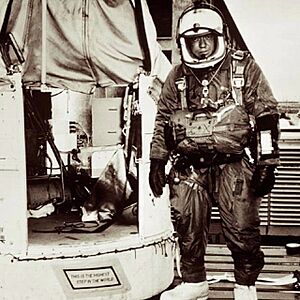Joseph Kittinger facts for kids
Quick facts for kids
Joseph W. Kittinger II
|
|
|---|---|
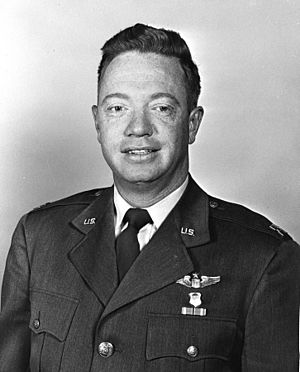
Colonel Joseph W. Kittinger II, USAF
(pictured as a captain) First person to conduct stratospheric space diving |
|
| Nickname(s) | Red |
| Born | July 27, 1928 Tampa, Florida, U.S. |
| Died | December 9, 2022 (aged 94) Orlando, Florida, U.S. |
| Allegiance | United States of America |
| Service/ |
|
| Years of service | 1950–1978 |
| Rank | |
| Battles/wars | Vietnam War |
| Awards | |
| Other work | Vice President of Flight Operations for Rosie O'Grady's Flying Circus (1978–1992) |
Joseph William Kittinger II (born July 27, 1928 – died December 9, 2022) was a brave officer in the United States Air Force (USAF). He served from 1950 to 1978, becoming a skilled fighter pilot. He retired as a Colonel, which is a high rank in the military.
For many years, Kittinger held the world record for the highest skydive. He jumped from an amazing 102,800 feet (31.3 kilometers) in 1960. This record stood for 52 years!
He was part of special high-altitude balloon projects called Project Manhigh and Project Excelsior. During these flights, he became the first person to clearly see the curvature of the Earth.
Kittinger also fought in the Vietnam War. He even shot down a North Vietnamese MiG-21 jet. Later, his own plane was shot down. He spent 11 months as a prisoner of war before returning home in 1973.
In 1984, he made history again by being the first person to cross the Atlantic Ocean alone in a gas balloon. In 2012, at age 84, Kittinger helped Felix Baumgartner with his record-breaking freefall from the stratosphere. Kittinger guided Baumgartner as the capsule communicator (CAPCOM).
Contents
Early Life and Air Force Career
Joseph Kittinger was born in Tampa, Florida, and grew up in Orlando, Florida. He loved planes from a young age. By the time he was 17, he flew a Piper Cub by himself.
In March 1949, he joined the United States Air Force. He finished his pilot training in March 1950 and became a second lieutenant. His first assignment was in Germany, where he flew F-84 Thunderjet and F-86 Sabre jets.
In 1954, Kittinger moved to Holloman Air Force Base in New Mexico. Here, he worked on aerospace medicine research. He flew a chase plane for Colonel John Stapp's rocket sled tests. Stapp was impressed by Kittinger's flying skills.
In 1957, Kittinger set a balloon altitude record of 96,760 feet (29,490 meters) during Project Manhigh. For this achievement, he received his first Distinguished Flying Cross.
Project Excelsior: Skydiving from the Edge of Space
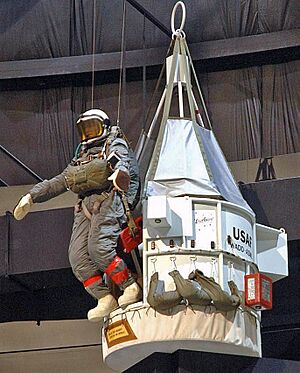
Kittinger was then assigned to the Aerospace Medical Research Laboratories in Dayton, Ohio. He worked on Project Excelsior, which means "ever upward." This project studied how to parachute from very high altitudes. He made three extreme parachute jumps from a special open gondola carried by huge helium balloons.
His jumps were done in a "rocking-chair" position. This was because he wore a heavy 60-pound (27 kg) kit and his pressure suit naturally formed a sitting shape.
Excelsior I: A Close Call
Kittinger's first high-altitude jump was on November 16, 1959, from about 76,400 feet (23,290 meters). It was almost a disaster! An equipment problem caused him to lose consciousness. Luckily, his automatic parachute opened and saved his life. He spun very fast, about 120 times per minute, setting another record for the forces he experienced.
Excelsior II: Another Successful Jump
On December 11, 1959, Kittinger jumped again from about 74,700 feet (22,770 meters). For this successful jump, he received the A. Leo Stevens Parachute Medal.
Excelsior III: The Record-Breaking Leap
On August 16, 1960, Kittinger made his final and most famous high-altitude jump from 102,800 feet (31,330 meters). He used a small drogue parachute to help him stay stable at first. He fell for 4 minutes and 36 seconds, reaching a top speed of 614 miles per hour (988 km/h). He opened his main parachute at 18,000 feet (5,490 meters).
During his ascent, his right glove stopped working, and his hand swelled to twice its normal size. But he kept going! Just before he jumped, he famously said, "Lord, take care of me now."
Kittinger described the feeling of falling: "There's no way you can visualize the speed. There's nothing you can see to see how fast you're going. You have no depth perception. You know you are going very fast, but you don't feel it."
Kittinger set several records: highest balloon ascent, highest parachute jump, longest time falling with a drogue parachute, and fastest speed by a human through the atmosphere. His records for highest parachute jump and fastest speed stood for 52 years. They were finally broken in 2012 by Felix Baumgartner during the Red Bull Stratos project.
For these amazing jumps, Kittinger was featured in Life and National Geographic Magazine. He received another Distinguished Flying Cross and the Harmon Trophy from President Dwight D. Eisenhower.
Project Stargazer: Looking at the Stars
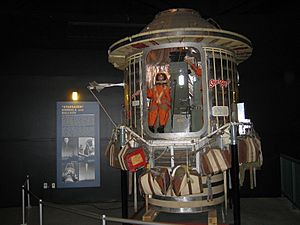
Back at Holloman Air Force Base, Kittinger participated in Project Stargazer in December 1962. He and astronomer William C. White took an open-gondola helium balloon to about 82,200 feet (25,050 meters). They spent over 18 hours up there, making astronomical observations.
Later Air Force Career and Vietnam War
In 1965, Kittinger was asked to help amateur parachutist Nick Piantanida break his high-jump record. Kittinger refused because he thought Piantanida's approach was too risky. Piantanida later had an accident during his jump attempt.
Kittinger served three times in the Vietnam War, flying 483 combat missions. He flew A-26 Invader and B-26K Counter-Invader planes.
Later, he flew the McDonnell Douglas F-4 Phantom II. In 1971–72, he commanded the 555th Fighter Squadron. During this time, he shot down a North Vietnamese MiG-21 jet.
On May 11, 1972, Kittinger's F-4 plane was hit by a missile from another MiG-21. He and his weapons systems officer, William J. Reich, ejected from the plane. They were captured and held as prisoners of war (POWs) in the Hỏa Lò Prison in Hanoi, also known as the "Hanoi Hilton".
Kittinger was the highest-ranking officer among the newer prisoners. He worked hard to keep up military structure among the POWs, which he believed was important for survival. Kittinger and Reich were released on March 28, 1973, as part of Operation Homecoming. Kittinger was promoted to full colonel while he was a prisoner.
After returning, Colonel Kittinger continued his Air Force career. He retired from the U.S. Air Force in 1978. He had flown 7,679 hours in the Air Force, including 948 combat hours in Vietnam. He also flew over 9,100 hours in civilian aircraft.
Later Civilian Career and Ballooning Records
After retiring from the Air Force, Kittinger worked for Martin Marietta (now Lockheed Martin). He also became a vice president for Rosie O'Grady's Flying Circus in Orlando.
Kittinger remained passionate about ballooning. In 1983, he set a world distance record for gas balloons. In 1984, he made history again by completing the first solo balloon crossing of the Atlantic Ocean. He launched his Balloon of Peace from Caribou, Maine, and landed four days later. This flight set another official world record for the longest gas balloon flight in its category. For this, he was featured in National Geographic Magazine again.
In the early 1990s, Kittinger helped NASA plan a project to break his highest parachute jump record, but the project was later stopped.
Kittinger joined the Red Bull Stratos project in 2012. He advised Felix Baumgartner on his record-breaking freefall from 128,100 feet (39,045 meters). Kittinger served as the CAPCOM (capsule communicator), guiding Baumgartner during his jump.
In 2013, Kittinger also helped balloonist Jonathan Trappe in his attempt to cross the Atlantic by cluster balloon.
Legacy and Honors
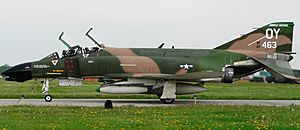
In 1997, Kittinger was honored by being inducted into the National Aviation Hall of Fame in Dayton, Ohio.
On January 23, 2007, the Civil Air Patrol renamed a squadron in Texas after him, the Colonel Joseph W. Kittinger Phantom Senior Squadron.
Kittinger was also mentioned in an episode of the British teen drama Skins. A character named Jal spoke about his amazing jump, saying, "He did it just because he could."
In 2009, Kittinger was honored in Caribou, Maine, where he launched his Atlantic balloon flight.
On February 20, 2013, Kittinger visited his old university, the University of Florida. He spoke to over 400 students and teachers about his role in the Red Bull Stratos project and his Excelsior III jump.
Colonel Joe Kittinger Park
In September 1992, Colonel Joe Kittinger Park was opened in Orlando, Florida. It is located near the Orlando Executive Airport. The park was temporarily closed for a highway project but reopened in March 2011.
In 2014, an amazing F-4 Phantom II aircraft was installed in the park. This particular F-4D (Air Force serial no. 65-0747) was one that Kittinger himself had flown many times during his service in Vietnam and Great Britain. Volunteers restored the aircraft, painting it with the colors of the squadron Kittinger commanded. It was officially dedicated on December 14, 2014.
Personal Life and Death
Joseph Kittinger passed away on December 9, 2022, at the age of 94. He died from lung cancer.
Images for kids
See also
 In Spanish: Joseph Kittinger para niños
In Spanish: Joseph Kittinger para niños


